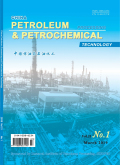- 钛学术文献服务平台 \
- 学术期刊 \
- 工业技术期刊 \
- 石油与天然气工业期刊 \
- 中国炼油与石油化工(英文版)期刊 \
Assembling Fe2O3/BiOCl Composite for Highly Effective Degradation of Water Pollutants under Visible-Light Irradiation
Assembling Fe2O3/BiOCl Composite for Highly Effective Degradation of Water Pollutants under Visible-Light Irradiation
基本信息来源于合作网站,原文需代理用户跳转至来源网站获取
摘要:
Fe2O3 was synthesized by the solvothermal method,and the synthesized Fe2O3 was added in the process of preparing BiOCl by hydrolysis,and then Fe2O3/BiOCl photocatalytic materials with different composite ratios were prepared.The optimal Fe2O3/BiOCl(1Fe/50Bi)sample showed a highest photocatalytic efficiency for cationic dyes(Rhodamine B)and anionic dye(methyl orange)degradation irradiated with visible light,as compared with that of a bare BiOCl catalyst.Meanwhile,radical capturing experiments indicated that the photo-induced holes(h+)is the main active species.X-ray powder diffraction and ultraviolet-visible diffuse reflectance spectroscopy were used to characterize the structural and optical properties,which proved that Fe2O3 was successfully composited to the BiOCl surface and effectively reduced the bandgap of BiOCl.More importantly,the optimal 1Fe/50Bi sample shows the highest photocatalytic efficiency for tetracycline(TC)degradation(98%)irradiated with visible light,as compared with that of a bare BiOCl catalyst.Consequently,the Fe,O,/BiOCl photocatalyst have potential applications in environmental purification.

推荐文章
Fe2O3/CAC低温脱硝实验研究
Fe2O3
活性焦
成型
低温脱硝
原位XRD研究Fe2O3的还原机理
原位XRD
Fe2O3
还原
碳化
铁基原位α-Fe2O3的制备与表征
原位
α-Fe2O3
富氧
RDX/Al/Fe2O3纳米复合材料的制备
材料科学
RDX
纳米复合材料
Al
溶胶-凝胶法
超临界干燥
内容分析
关键词云
关键词热度
相关文献总数
(/次)
(/年)
文献信息
| 篇名 | Assembling Fe2O3/BiOCl Composite for Highly Effective Degradation of Water Pollutants under Visible-Light Irradiation | ||
| 来源期刊 | 中国炼油与石油化工(英文版) | 学科 | |
| 关键词 | |||
| 年,卷(期) | 2022,(1) | 所属期刊栏目 | Catalyst Research |
| 研究方向 | 页码范围 | 59-67 | |
| 页数 | 9页 | 分类号 | |
| 字数 | 语种 | 英文 | |
| DOI | |||
五维指标
引文网络
引文网络
二级参考文献 (0)
共引文献 (0)
参考文献 (0)
节点文献
引证文献 (0)
同被引文献 (0)
二级引证文献 (0)
2022(0)
- 参考文献(0)
- 二级参考文献(0)
- 引证文献(0)
- 二级引证文献(0)
引文网络交叉学科
相关学者/机构
期刊影响力
中国炼油与石油化工(英文版)
主办单位:
中国石化集团石油化工科学研究院
出版周期:
季刊
ISSN:
1008-6234
CN:
11-4012/TE
开本:
大16开
出版地:
北京海淀学院路18号
邮发代号:
创刊时间:
1999
语种:
eng
出版文献量(篇)
1608
总下载数(次)
0
总被引数(次)
1651
期刊文献
相关文献
推荐文献
- 期刊分类
- 期刊(年)
- 期刊(期)
- 期刊推荐
一般工业技术
交通运输
军事科技
冶金工业
动力工程
化学工业
原子能技术
大学学报
建筑科学
无线电电子学与电信技术
机械与仪表工业
水利工程
环境科学与安全科学
电工技术
石油与天然气工业
矿业工程
自动化技术与计算机技术
航空航天
轻工业与手工业
金属学与金属工艺
中国炼油与石油化工(英文版)2022
中国炼油与石油化工(英文版)2021
中国炼油与石油化工(英文版)2020
中国炼油与石油化工(英文版)2019
中国炼油与石油化工(英文版)2018
中国炼油与石油化工(英文版)2017
中国炼油与石油化工(英文版)2016
中国炼油与石油化工(英文版)2015
中国炼油与石油化工(英文版)2014
中国炼油与石油化工(英文版)2013
中国炼油与石油化工(英文版)2012
中国炼油与石油化工(英文版)2011
中国炼油与石油化工(英文版)2010
中国炼油与石油化工(英文版)2009
中国炼油与石油化工(英文版)2008
中国炼油与石油化工(英文版)2007
中国炼油与石油化工(英文版)2006
中国炼油与石油化工(英文版)2005
中国炼油与石油化工(英文版)2004
中国炼油与石油化工(英文版)2003
中国炼油与石油化工(英文版)2002
中国炼油与石油化工(英文版)2001
中国炼油与石油化工(英文版)2000

 免费查重
免费查重










